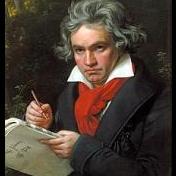Search the Community
Showing results for tags 'voice leading'.
-
According to this article, 4 part chorale-like voice leading (part writing), despite being taught in music conservatories, is not used in orchestral music. I understand the basic concepts of voice leading, voice independence, which note to double, and resolving in the "right" direction, but I haven't worried to much about learning strict textbook voice leading. (I admit these concepts can be hard to prioritize and I think that might be where I got the idea of adding another voice or two) I know it's a lot, but here are the things I want to clear up for myself: 1. When people write in more than four voices, do they use standard 4 part voice leading and add in additional parts to fill in space, or do they voice lead all of the parts? I imagine both methods are used, but what do I know? 2. Is it easier to voice lead in, say 5 parts, rather than in 4? I understand that the more voices you add, the more responsibility you have to lead (resolve?) all of them, but I feel like a lot of specific rules for specific situations come from the limitations of 4 parts. For example I feel like it might be easier to balance doubling the correct note and writing independent lines, in 5 voices. 3. How is voice leading used in modern composition? I would probably just voice lead the chords and write the melody and countermelody together separate from the chords, not considering them in voice leading (of course except for the difference between perfect authentic cadences and imperfect authentic cadences). 4. How worried are modern composers (I'm sure there's a difference between media composers and "academic" concert stage composers) about line independence and not using parallel fifths octaves and unisons? I know I would never (never say never) try to voice lead in say, eight voices, because it would be impossible to avoid forbidden parallels unless you have a ton of upper chord extensions, like jazz. 5. Do people (if no one does it, I might try it) ever use a different amounts of voices in different sections of a single piece (i. e. five voices in the A section and four in the B section)? If I were to do this, I would redistribute the parts to the instruments, so that doesn't equate to parallel unisons, but this "redistribution" would happen anyway since different sections normally have a different set of instruments. This is just an idea I got, but I'm sure it's not original. 6. Are there any existing systems to voice lead in more than four parts, or is it just the same basic principles (or is only four part voice leading taught, leaving the rest to the composer to figure out)? I know this is a longer post, and I can probably figure some of it out myself, but I would be thrilled if someone of more experience were to offer some insight. P.S. Just to clarify, I know that orchestral music uses part doublings on top of the original part writing; I'm not asking about that.
-
So I was feeling fine yesterday, until I got into a bit of an emotional state(okay, a lot a bit). And even a few hours after it stopped, all that came out of me when I played the piano was minor key after minor key. I guess yesterday was one of my minor key days, I have those. And one of the things that I liked was a basic melody set in the La Folia progression and I thought: And this is how it came out when I was improvising the theme for said Theme and Variations on the piano: As you can see, my voice leading is as stepwise as I can make it and the La Folia progression that I am using lends itself well to an almost completely stepwise voice leading. But I was told that my line of D, C#, D, C, C, C, D, C# is more like a tenor line than a bass line because it doesn't move much and that I should make the bottom line of the chords more dynamic. But how? What I have here is the smoothest possible way of voicing the progression. I was also told about the parallel fifths that occur when I go from D minor to C major and then from C major to D minor, but that depending on the style I'm going for, these parallel fifths may or may not be a problem. The reason for the D minor key? Simple, it's the most common key I see the La Folia progression set in, be it Baroque era, Classical era, or Modern era. Plus it was the key I was improvising this theme in on the piano. I'm currently listening to Salieri's 26 Variations on La Folia to get ideas of how I could vary this theme(not that I didn't already have quite a few, but nothing wrong with having more). This is what my Theme and Variations currently sounds like and I will also include a PDF of it.
-
Hi all! It's been a while since I've been on... and I'm returning with a question about Fux's counterpoint from Alfred Mann's The Study of Counterpoint: Are the solutions to each of Aloysius' examples (with corrections) the only acceptable solutions? In attempting to complete the very first exercise (first species counterpoint on the given cantus firmus, in the bottom voice, in dorian mode), I find there are good reasons to rule out most of the consonances that could be considered. However, I don't know if there are hard and fast rules which make the answers that Joseph gives the ONLY possible answers. Anyone have experience with this problem or insights? Thanks!
- 4 replies
-
- counterpoint
- voice leading
-
(and 4 more)
Tagged with:
-
TL;DR underneath. When I first learned things about harmony and voice leading, I learned to avoid parallel and direct fifths and octaves, to avoid dissonances, and things like that, because they're against the rules. I reasoned that the rules weren't arbitrary, so they had to be there for a reason; people want their music to be likeable, things that sound bad aren't likeable, therefore, invent rules to keep music from straying into the boundary of bad. But, as everyone knows, one of the first responses to that is, 'But that doesn't sound bad!', and the reply, 'It diminishes the independence of voices'. When I first learned this, I simply thought there was something wrong with my ears, because I often couldn't spot errors except by sight; however, when I recently began studying counterpoint, I listened to my exercises on Finale and/or played them on the piano, and my rate of mistake-spotting went much higher, along with my finding some things that I particularly disliked. This, obviously wasn't anything to do with hearing them, 'cause I'd been doing that all along with pieces; but I took it to be simplification of texture (I hate octaves or any interval but an imperfect one in two voices, on the beat - three, not so much - four, impossible to avoid in a standard chorale setting). And there were numerous 'exceptions' to the 'rules' (e.g., direct fifths okay between inner voices &c.). Often, these were just things that couldn't be avoided, but I figured that, if they were allowable just because they were unavoidable (Mozart fifths, for example), and some people don't notice them from just hearing the piece, but may spot them by sight, then they can't be that bad! In that spirit, I've posted six short phrases, all in common time and ending with a whole note, that increase gradually in complexity, in a couple of tempos and with a few renderings. I'd like people to listen to them, listen out for mistakes, and post any you spot, here, in a spoiler. You can range from saying what the mistake is and between what voices, or simply stating where it occurs without knowing exactly what it is. Of particular interest is if people can only spot the error in a certain rendering (which I doubt) or a different tempo (which I don't). Please do not use any theoretical skills to work out where they are: this isn't a test or somewhere to show off your aural abilities, and you'll just ruin it for me and everyone else involved. This essentially amounts to listening and pointing out things and/or parts you didn't like. I'll post the score as a spoiler when a tolerable amount of people respond. TL;DR As an experiment in observing the practicality of abstract counterpoint; listen to these six phrases and point out what sounds technically crap. 110 BPM Piano VST Harpsichord VST Piano MIDI 55 BPM Piano VST Harpsichord VST Piano MIDI
- 21 replies
-
- counterpoint
- voice leading
-
(and 2 more)
Tagged with:
-
I wrote this as a part-writing exercise, recorded the audio and paul-stretched it. Then I added some paul-stretched finger snaps and hand noises with a little reverb and equalizing. I was pleasantly surprised by how enjoyable this was! :) I've uploaded a pdf of the chorale I used for anyone who's curious. Any comments about either my finished product of the chorale would be welcome, I'm using chorale writing as a "workout" to strengthen some skills I've been working on. p.s the sound you hear @ 1:18 is the school bell ringing... I caught it as I was recording. It surprised me when I listened, but liked it so I kept it. Thanks y'all! Gustav Johnson
- 6 replies
-
- voice leading
- chorale
-
(and 1 more)
Tagged with:
-
So, when I first started theory I was told that retrograde (movement from a dominant function chord to a pre-dominant function chord) was strictly forbidden in common practice harmony. However, while working through Hindemith's "Traditional Harmony" I found that several of Hindemith's prescribed progressions in the exercises have retrograde progressions. So, is retrograde strictly forbidden? Are there exceptions? Am I just stupid? Discuss.
- 13 replies
-
Why do we avoid the augmented second between 6 and 7 in harmonic minor in voice leading? I always get called on this in my compositions, but I use that interval on purpose. It sounds so expressive and pulls so strongly to tonic, why avoid it? It's not like singers can't sing it now. Contemporary singers should find an augmented second very easy to sing. It isn't hard on any instrument. So why? Why do we avoid the augmented second in voice leading?






